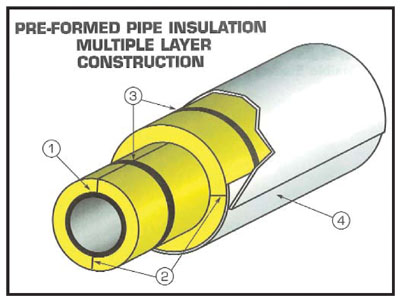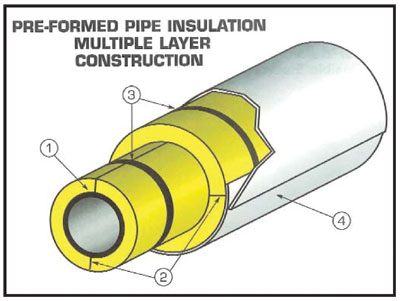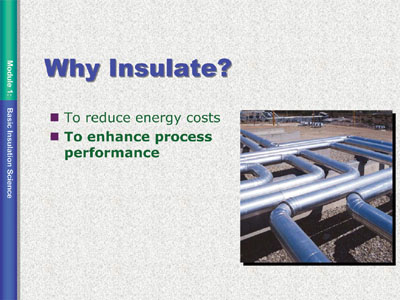Mechanical Insulation Basics Part Two: Time for a Review
This article is the second in a two-part series covering mechanical insulation basics. Part 1 of this series in the November issue discussed basic insulation science, system design and materials, and insulation thickness determination. This article will take a more detailed look at installation considerations, the specification process, and insulation system maintenance.
Installation Considerations
Not everyone can become a trained and experienced insulation estimator, but everyone who deals with mechanical insulation can at least understand the correct installation of different types of insulation systems. The NITP introduces students to the Midwest Insulation Contractors Association’s (MICA’s) manual, National Commercial and Industrial Insulation Standards, and the Process Industry Practices (PIP).
Laymen looking at an insulated industrial pipe really just see the jacketing—probably oxidized aluminum sheet. They have no concept of what may lie beneath. Figure 1, from the MICA manual, gives the details.
The system in Figure 1 consists of a double layer of high-temperature insulation material (see number 1). The insulation material is probably preformed calcium silicate, perlite, mineral wool, or fiberglass. It also has wire, banding, or tape holding the insulation sections in place (see number 3), as well as staggered and sealed lap and butt joints (see number 2). It has metal jacketing, overlapped several inches on both the lap and butt joints, and mechanically held in place with rivets (see number 4).
Every detail is there for a reason. The following are good examples of this:
- The overall thickness provides the engineered heat loss or surface temperature limitation (also a function of the metal jacketing’s emittance).
- The staggered joints prevent straight-through radiation and convection paths for additional heat loss.
- The metal jacketing, with the overlaps and caulking, provides both mechanical protection and protection from rain, wind, and sunshine.
Although these details are not immediately visible, they are critical to the successful performance of the insulation system.
The average layman is even less knowledgeable about how elbows might be insulated on a large pipe operating at a high temperature. The MICA manual’s Plate 11 shows this detail (see Figure 2).
In Figure 2, number 1 refers to the pipe; number 2 to the pipe insulation; number 3 to the mitered insulation segments, cut to form a tight fit; number 4 is the metal jacketing; number 5 is the wire, banding, or tape; number 6 refers to the fitting metal jacketing gore; and number 7 refers to the mechanical fasteners. Every detail serves a function.
It takes a lot of work for a fabricator to make the insulation and metal jacketing gores, and for a skilled insulator to install these elbow materials. If the fabricator does not do the job well, the parts will not fit correctly and will either leave gaps between the insulation gores or require cutting down of the insulation gore sections to get them to fit. In cases with undersized insulation gores, there could be excess heat loss and increased surface temperatures unless the insulator takes extra time to fill in the gaps with mastics. Sometimes insulators must spend extra time to make oversized insulation gores fit. If the metal jacketing gores are not fabricated or installed correctly, rainwater may get into the insulation, causing part of it to become wet and increasing heat loss from the insulated pipe. If it is an above-ambient, low-temperature system (operating between 75° and 250°F) with uncoated carbon steel pipes, corrosion under insulation (CUI) might occur due to poor fitting or poorly caulked metal jacketing. The details make or break the mechanical insulation system.
The MICA manual and the PIP manual are current. However, there are some new materials on the market that should be included when these documents are next revised. One would be the inclusion of aerogel blanket insulation, a very low thermal conductivity insulation that has been developed this decade. In addition to its low thermal conductivity (giving it about R-10 to the inch), it is flexible, resilient, robust, and hydrophobic—an interesting combination of properties. However, when installed as a mechanical insulation, it does not meet the standard dimensions that preformed pipe and tank insulation do—namely, those given in American Society for Testing and Materials (ASTM) C585. Hence, fabricators and insulation contractors must make adjustments to get a good fit between straight sections and fittings, especially between metal-jacketed straights and preformed metal elbows.
A second new material is the class of flexible, laminated, self-adhering jacketing materials. In some applications, these may be more suitable than conventional aluminum jacketing. In particular, some have a zero vapor permeance and seal air (and vapor) tightly. In addition, with the self-adhered joints, water intrusion should be less of a problem.
Specification Process
The mechanical insulation industry is doing better today than it was 6 years ago when the NITP began. Those in the industry are running to keep pace with new construction projects “coming out of the ground,” as well as those still “in the pipeline.” The specification process is much more important now because of the abundance of work being specified in preparation for new construction.
Some current specifications are new, and others have simply been taken off the shelf, dusted off, and included with project bid documents. In either case, the specs still accomplish the same goal: to allow the owner or operator (perhaps through an engineering firm) to communicate to the bidding contractors what is required for a project. For mechanical insulation, this includes the types of materials (including accessory materials, such as those that hold the insulation jacketing onto the insulated pipe), insulation thicknesses, installation requirements, scope, technical submittal requirements, and quality requirements. With new projects, the insulation specification is more important than ever.
The contractor is advised to read the specification thoroughly before submitting a base bid. Of course, contractors also must understand the schedule requirements to provide a good proposal. If they think they can improve system performance and/or reduce the installed cost while improving the schedule, they may be allowed or even encouraged to provide an alternate bid.
When offering a base bid, contractors are not responsible for system performance as long as they follow the specification exactly to every detail. If an alternate bid is accepted, then the contractor takes on some additional risk, even if the client’s engineering firm approved the bid.
Different materials can be used, within their temperature limitations, on any particular application. For example, to insulate 45°F chilled water lines, numerous materials can be specified, including all service jacket (ASJ) or foil-scrim-kraft (FSK) jacketed fiberglass and mineral wool pipe insulation; flexible elastomeric foam tube or sheet; or preformed pipe insulation made from polystyrene, polyisocyanurate, phenolic foam, or cellular glass.
Some materials are less expensive to purchase than others, some are less expensive to fabricate than others, and some are easier and faster to install. Owners and operators want the lowest installed cost. However, if they want the system to last, they should take durability and longevity into account when writing the specification. If getting the lowest first cost for the project is a high priority, they may get just that—a system that performs well at first, but not for more than a couple of years. If owners and operators want an insulation system that lasts, they must have an engineer write the specification with durability in mind.
A well-maintained insulation system should last 20 to 25 years. For that to happen, however, the system must be intelligently specified, and the resulting specification must be followed by the insulation contractor. To do that, the general contractor and/or the owner should know and enforce that specification. For the owner/operator, the rule that holds is “pay now or pay later.” Specifiers have a variety of sources for technical information on products that make up mechanical insulation systems. Some of these include the following:
- The National Insulation Association’s (NIA’s) website (www.insulation.org)
- MICA’s National Commercial & Industrial Insulation Standards Manual (6th Edition)
- The ASTM Book of Standards, Volume 04.06 (updated every year)
- The North American Insulation Manufacturers Association’s (NAIMA’s) 3E Plus® computer program (updated periodically)
- Arcom MASTERSPEC
- PIP manual on mechanical insulation (updated in 2006)
- The American Society of Heating, Refrigerating and Air Conditioning Engineers’ (ASHRAE’s) 2005 Handbook of Fundamentals, Chapter 26 (to be updated in 2009)
At www.insulation.org, the Guide to Insulation Product Specifications, the Insulation Materials Specification Guide, and the MTL Product Catalog are good resources for specifiers. Additional references, including past articles from Insulation Outlook in the magazine’s archives, can be of value as background material.
The ASTM Book of Standards, Volume 04.06 includes specifications for most of the different insulation materials that are commercially available (two exceptions are microporous insulation and aerogel blanket insulation, both of which are currently in the process of being developed by ASTM Committee C16). ASTM also has testing standards, such as for testing thermal conductivity, compressive strength, and so forth. These are referenced in the ASTM material standards and may be referenced in a project specification. Occasionally, military specifications (MILSPECS) are referenced.
Chapter 26 of ASHRAE’s 2005 Fundamentals Handbook covers “Thermal Insulation for Mechanical Systems.” This chapter is particularly helpful for commercial building mechanical insulation system design. Also, the MASTERSPEC series for all building construction can be a great aid to specifying engineers who are starting from scratch on a new project.
Insulation System Maintenance
Facility owners and operators may have an excellent insulation specification, purchase quality materials, and have the materials installed exactly as specified, but if they do not properly maintain the system, performance will decrease over time. Nothing lasts forever. The better an insulation system is maintained, the longer it lasts and the better its performance. Maintenance is not free, but it is critical.
Mechanical insulation is used to reduce energy use, control a process, provide personnel protection, prevent condensation, provide freeze protection, and more. If the insulation becomes crushed, gets wet, or degrades from severe vibration, it will not provide the thermal performance for which the insulation system was designed.
Again, it is pay now or pay later. Usually, paying later is much more expensive than it would have been to maintain the system all along.
When owners and operators consider today’s energy costs (for example, $10 per million Btus of natural gas) and evaluate their insulation systems for missing or damaged materials, it is obvious that fixing insulation pays for itself within a few months, if not a few weeks. (See “How Many Barrels of Oil Can Mechanical Insulation Save?” at www.insulation.org/articles/article.cfm?id=IO050505.) Typical return on investment (ROI) for insulation upgrade projects occurs in less than a year.
Poorly maintained mechanical insulation can result not only in higher than design energy use, but also in other costly problems. Corrosion under insulation can occur in mild-temperature (75° to 250°F) uncoated carbon steel surfaces when the insulation gets and stays wet for an extended period of time, particularly in a rainy location close to a body of salt water. Water intrusion occurs when the metal jacketing is not well maintained—including caulking of all the joints and maintaining that caulking. Metal jacketing can leak around joints, particularly where there are penetrations for pipe hangers, supports, or fittings. Over time, if CUI develops as a result of wet insulation, remediation of the problem can be extremely costly.
If a chilled pipe’s vapor retarder or vapor barrier is not well maintained (assuming that it was well specified in the first place), moisture likely will get into the insulation and migrate to the chilled pipe. Besides the obvious energy waste, dripping water can lead to mold growth, corrosion of building structural members, destroyed ceiling panels, electrical shorts, and more.
Mechanical insulation systems must be well maintained, and they do not maintain themselves. Facility owners and operators must put sufficient money into their budgets and then make certain that the work gets done. To do otherwise is simply uneconomical and, in some cases, unsafe.
Back to Basics
Numerous resources are available to help engineers design an insulation system for a particular application and make sure it is installed correctly. Collectively, these resources provide an extensive knowledge base and can be extremely useful.
It is critical to review mechanical insulation basics with an emphasis on proper installation and maintenance every once in a while. When insulation is correctly designed and installed as part of a system, it provides a cost-effective solution to excess heat loss or heat gain.




